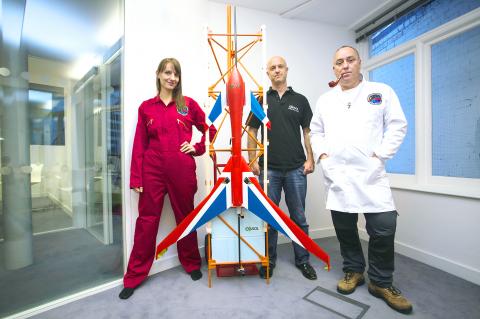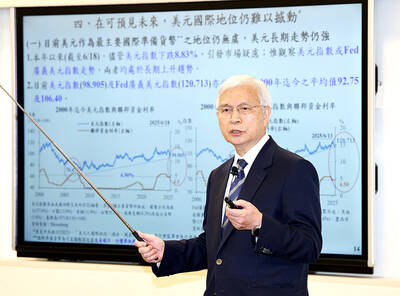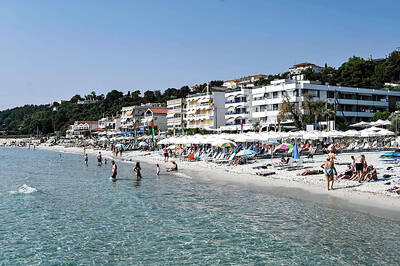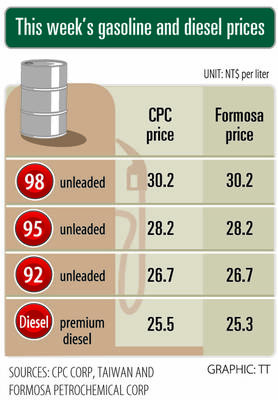Fueled by beer and the enthusiasm of amateurs, a British team on Friday said it was preparing to launch the world’s first ever 3D printed rocket.
Showing off the human-sized rocket in a central London office, Lester Haines, head of the “Special Projects Bureau” at technology magazine The Register, described the technical challenges and “big future” of 3D printing in aeronautics.
“You can do highly complex shapes that simply aren’t practical to do any other way,” he said, dressed in a white lab coat sporting the project motto “Ad astra tabernamque,” which means “to the stars and the pub.”

Photo: AFP
“NASA are already 3D-prinsting metal rocket parts, so it’s obviously got a big future,” he said.
The project — sponsored by German data analytics firm Exasol AG — was suggested by readers of The Register and goes by the grand title “Low Orbit Helium Assisted Navigator,” or LOHAN for short.
It took 30 committed team members, including doctorate aeronautical engineers, four years to build the rocket.
The biggest challenge was getting the standard hobbyist rocket motor to fire at high altitudes, Haines said.
The team said it plans to launch the rocket from Spaceport America, the home of Virgin Galactic in New Mexico, later this year, after securing the £15,000 (US$24,000) needed for liftoff on crowdfunding site Kickstarter.
A huge helium balloon will lift the rocket 20,000m into the stratosphere, at which point the onboard GPS is set to ignite the engine, catapulting it to speeds of about 1,610kph.
The 3kg rocket, which cost £6,000 to print, is then scheduled to use an onboard autopilot to guide it back to Earth, all captured by an onboard video camera.
Haines explained how 3D printing’s main advantage was in speeding up the process of refining prototypes, requiring only a tweak to the computer-aided design plans that instruct the printer.
He called LOHAN “a because it’s there project,” which had no commercial value, but added that the number of potential uses for similar unmanned aerial vehicles was “endless.”
With the countdown on, Haines dispelled any suggestions the crew was feeling the pressure.
“We got some of the team turning up for a beer tonight,” he revealed. “It’s going to get really messy.”

NOT JUSTIFIED: The bank’s governor said there would only be a rate cut if inflation falls below 1.5% and economic conditions deteriorate, which have not been detected The central bank yesterday kept its key interest rates unchanged for a fifth consecutive quarter, aligning with market expectations, while slightly lowering its inflation outlook amid signs of cooling price pressures. The move came after the US Federal Reserve held rates steady overnight, despite pressure from US President Donald Trump to cut borrowing costs. Central bank board members unanimously voted to maintain the discount rate at 2 percent, the secured loan rate at 2.375 percent and the overnight lending rate at 4.25 percent. “We consider the policy decision appropriate, although it suggests tightening leaning after factoring in slackening inflation and stable GDP growth,”

DIVIDED VIEWS: Although the Fed agreed on holding rates steady, some officials see no rate cuts for this year, while 10 policymakers foresee two or more cuts There are a lot of unknowns about the outlook for the economy and interest rates, but US Federal Reserve Chair Jerome Powell signaled at least one thing seems certain: Higher prices are coming. Fed policymakers voted unanimously to hold interest rates steady at a range of 4.25 percent to 4.50 percent for a fourth straight meeting on Wednesday, as they await clarity on whether tariffs would leave a one-time or more lasting mark on inflation. Powell said it is still unclear how much of the bill would fall on the shoulders of consumers, but he expects to learn more about tariffs

Greek tourism student Katerina quit within a month of starting work at a five-star hotel in Halkidiki, one of the country’s top destinations, because she said conditions were so dire. Beyond the bad pay, the 22-year-old said that her working and living conditions were “miserable and unacceptable.” Millions holiday in Greece every year, but its vital tourism industry is finding it harder and harder to recruit Greeks to look after them. “I was asked to work in any department of the hotel where there was a need, from service to cleaning,” said Katerina, a tourism and marketing student, who would

i Gasoline and diesel prices at fuel stations are this week to rise NT$0.1 per liter, as tensions in the Middle East pushed crude oil prices higher last week, CPC Corp, Taiwan (台灣中油) and Formosa Petrochemical Corp (台塑石化) said yesterday. International crude oil prices last week rose for the third consecutive week due to an escalating conflict between Israel and Iran, as the market is concerned that the situation in the Middle East might affect crude oil supply, CPC and Formosa said in separate statements. Front-month Brent crude oil futures — the international oil benchmark — rose 3.75 percent to settle at US$77.01